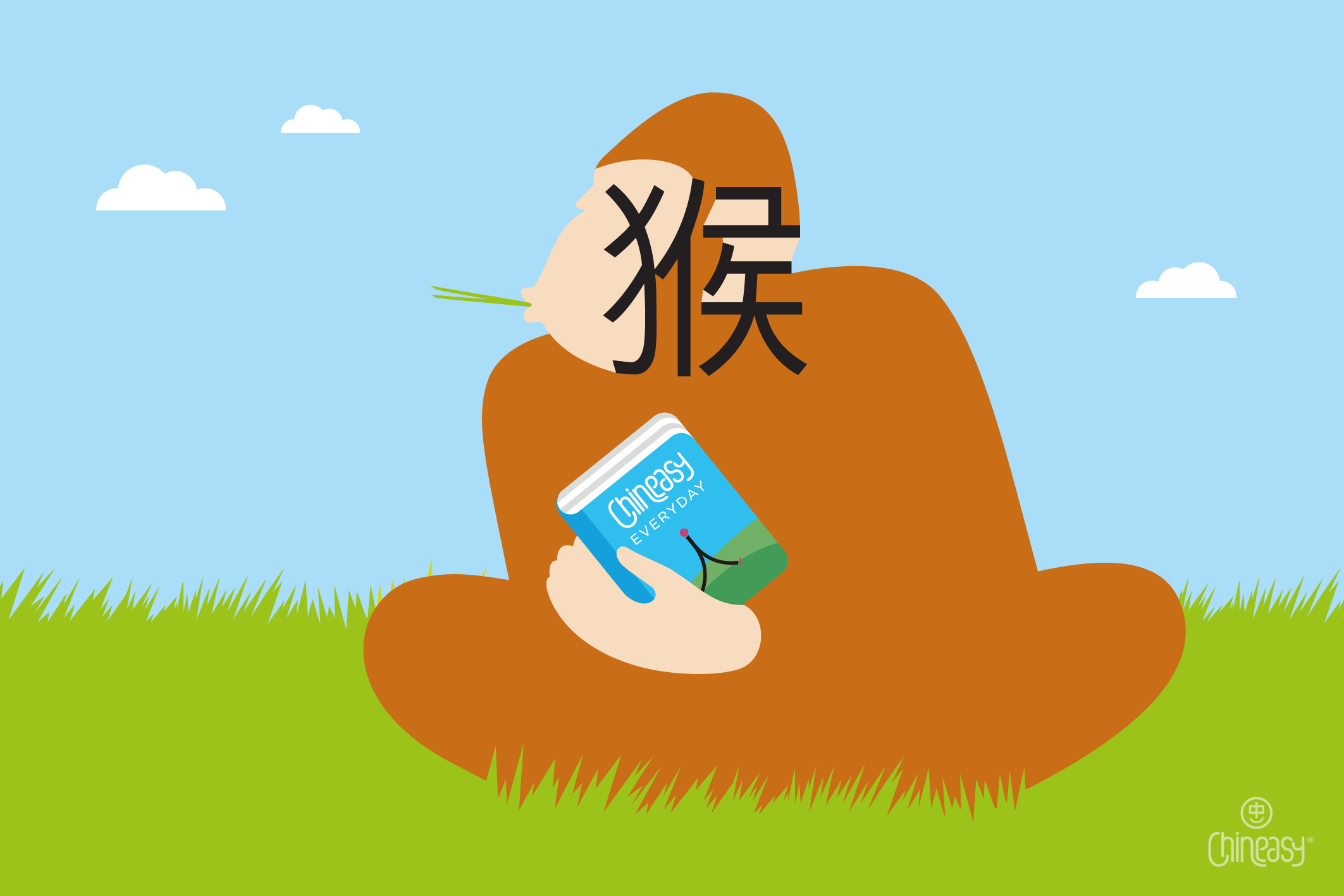You’ve picked up a good amount of Chinese vocabulary and now want to take your skills further. The next step?
Mastering a few basic Chinese sentence patterns elevates your communication to complete sentences.
In this post, we’re covering 5 essential structures that are the backbone of the Chinese language. Armed with these, you’ll be able to express yourself more clearly and confidently.
Let’s dive in and lay the foundation for your journey in Chinese!
Subject + Verb + Object (SVO)
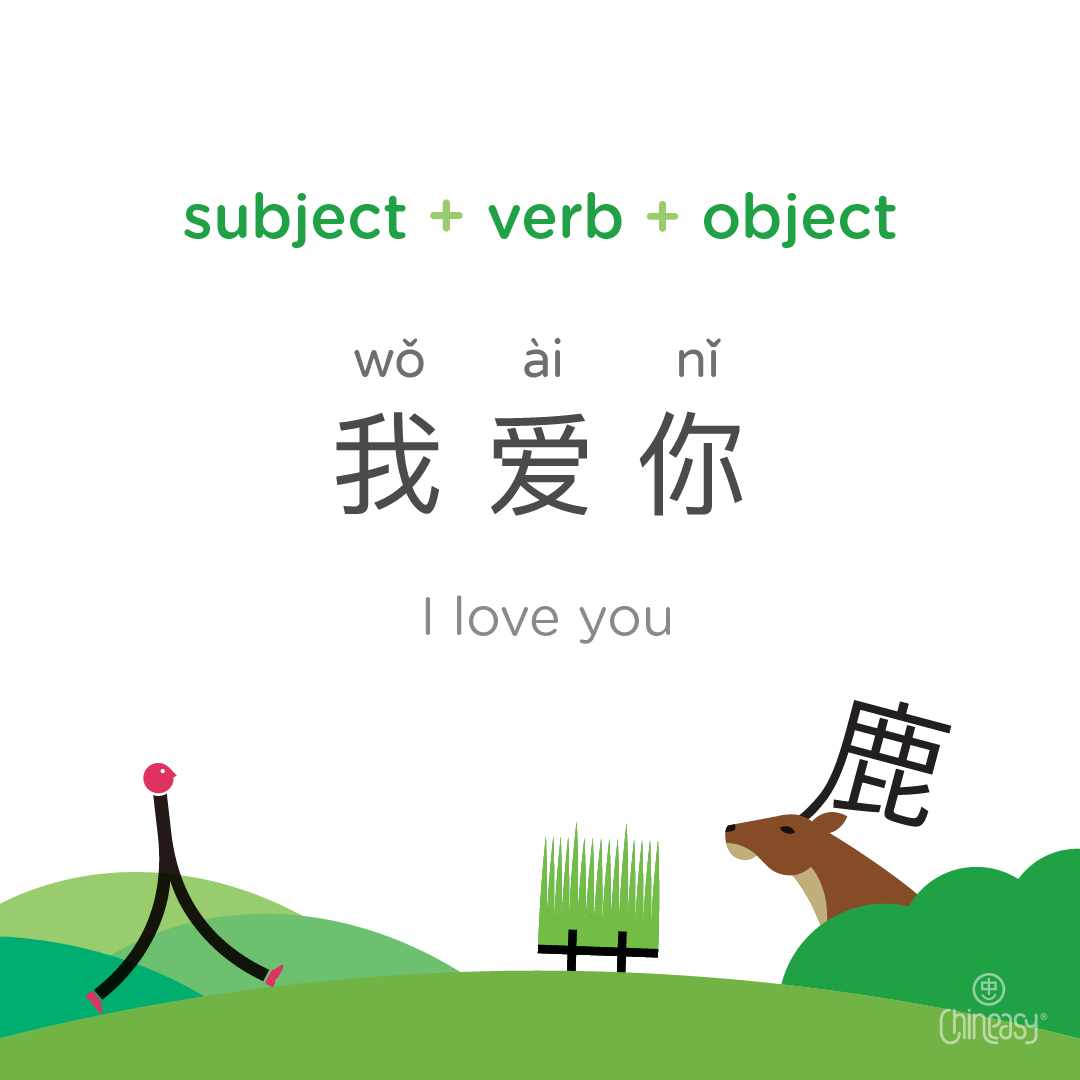
This foundational structure, SVO, is prevalent across many languages.
The sentence starts with a subject, which could be a pronoun like 我 (wǒ) for “I,” or a name such as 安娜 (ānnà) for “Anna.”
Following the subject is a verb, such as 愛/爱 (ài) for “to love,” 喜歡/喜欢 (xǐhuān) for “to like,” or 吃 (chī) for “to eat.”
The sentence ends with an object. Objects can be tangible, like books, cups or pronouns like “me” or “you.”
A unique aspect of Chinese is the interchangeability of subject and object pronouns based on context; 我 (wǒ) can mean “I” or “me,” and 他 (tā) can mean “he” or “him.”
Here are examples employing the SVO structure:
- I love you: 我愛你/我爱你 (wǒ ài nǐ) – Literally: I + love + you
- He likes me: 他喜歡我/他喜欢我 (tā xǐhuān wǒ) – Literally: he + likes + I/me
- Anna eats meat: 安娜吃肉 (ānnà chī ròu) – Literally: Anna + eats + meat
Note: Chinese verbs don’t change form based on the subject. In other words, Chinese does not have any verb conjugations.
Subject + 是 + Noun
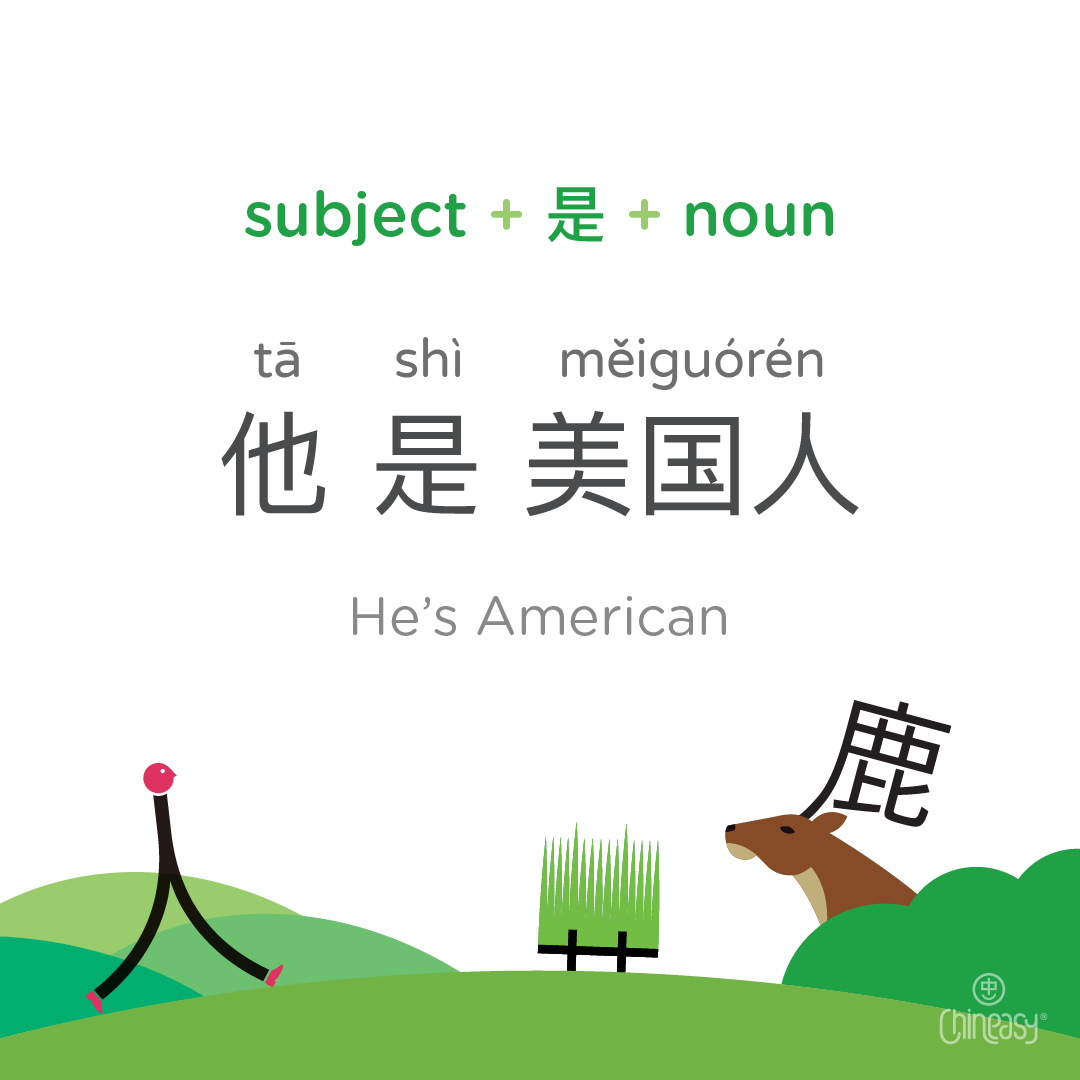
In Chinese, 是 (shì) plays a pivotal role, functioning similarly to “am,” “are,” or “is” in English. It connects the subject with a noun to express identity or possession.
Let’s look at how this structure works:
- I’m a student: 我是學生/我是学生 (wǒ shì xuéshēng) – Literally: I + 是 + student
- He’s American: 他是美國人/他是美国人 (tā shì měiguórén) – Literally: He + 是 + American
- Today is Wednesday: 今天是星期三 (jīntiān shì xīngqīsān) – Literally: Today + 是 + Wednesday
The form of 是 remains constant, regardless of the subject. Importantly, 是 is used to link subjects with nouns, not adjectives.
Subject + 很 + Adjective
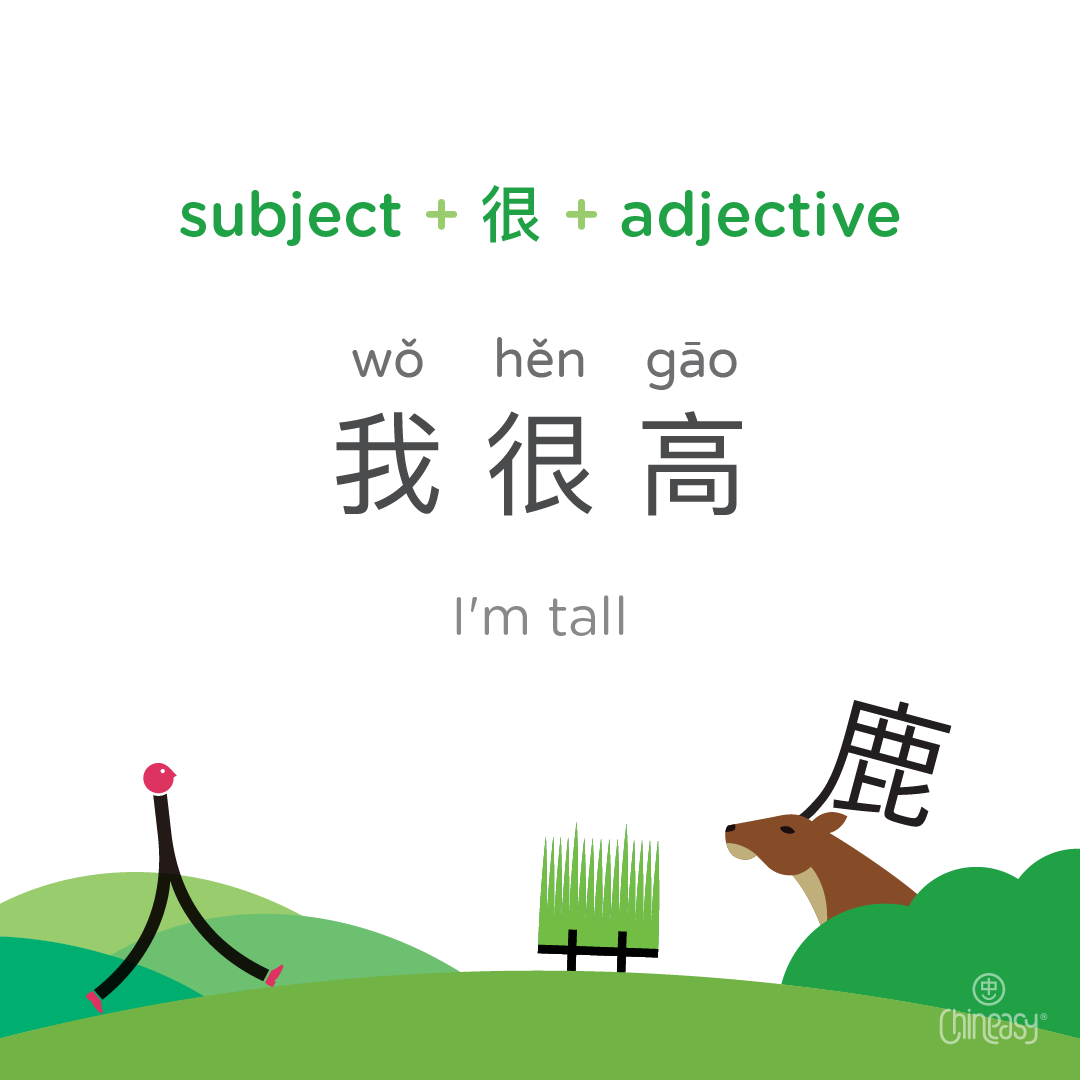
When you want to describe someone or something with an adjective in Chinese, you’ll use the 很 (hěn) structure.
Unlike English, where “am,” “are,” or “is” directly connect subjects to adjectives, Chinese typically uses 很 (hěn) for this purpose.
Check out these examples:
- I’m tall: 我很高 (wǒ hěn gāo) – Literally: I + 很 + tall
- He’s busy: 他很忙 (tā hěn máng) – Literally: He + 很 + busy
- Chinese is easy: 中文很容易 (zhōngwén hěn róngyì) – Literally: Chinese + 很 + easy
Though 很 often means “very,” in this structure, it doesn’t add extra emphasis — it simply links the subject and adjective, serving more as a grammatical connector than implying intensity.
Subject + Time + Verb
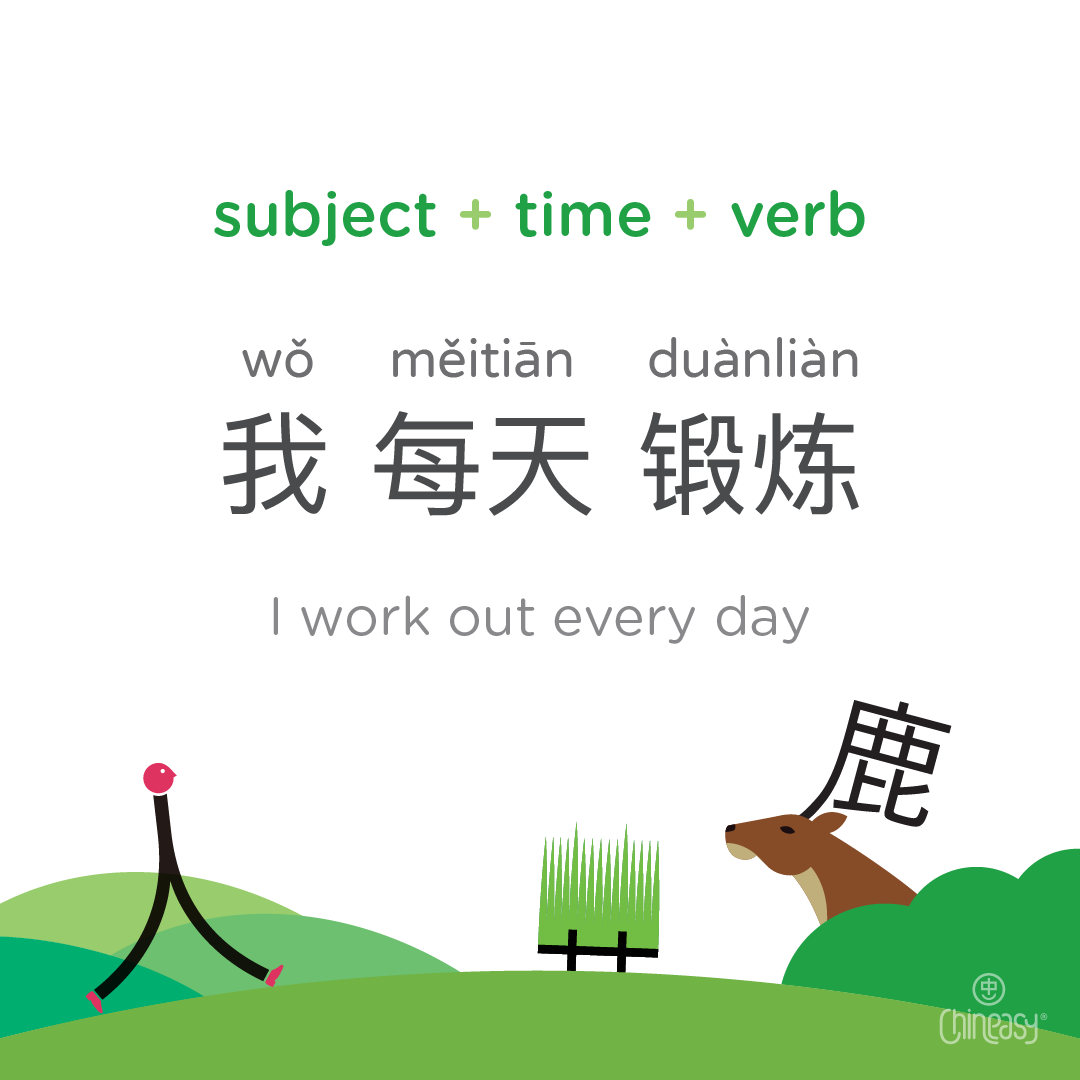
This structure specifies when an action occurs by positioning the time element right after the subject and before the verb.
It differs from the typical sentence construction in many European languages, including English, where time elements often come at the end.
Here are examples showcasing this structure with time expressions:
- I work out every day: 我每天鍛鍊/我每天锻炼 (wǒ měitiān duànliàn) – Literally: I + every day + work out
- He graduates next year: 他明年畢業/他明年毕业 (tā míngnián bìyè) – Literally: He + next year + to graduate
- Anna will visit me tomorrow: 安娜明天来看我 (ānnà míngtiān huì lái kàn wǒ) – Literally: Anna + tomorrow + to come + see + I/me
Usually, time words go right after the subject. But, if you want to focus more on when something happens than what happens, you can put the time at the start of the sentence.
Another twist is when you’re mentioning how long something takes, like “two hours” or “three weeks.” In these cases, the duration goes at the end of the sentence. For example:
- I work out every day for two hours: 我每天鍛鍊兩個小時/我每天锻炼两个小时 (wǒ měitiān duànliàn liǎng ge xiǎoshí) – Literally: I + every day + work out + two + 個/个 (measure word) + hour
Subject + Time + Location + Verb

Adding a location into the mix, this structure lets you detail not just when but also where an action takes place, providing a fuller picture of the event.
Examples:
- I work in Shanghai this year: 我今年在上海工作 (wǒ jīnnián zài shànghǎi gōngzuò) – Literally: I + this year + in + Shanghai + to work
- He was born in the USA in 1996: 他1996年在美國出生/他1996年在美国出生 (tā yījiǔjiǔliù nián zài měiguó chūshēng) – Literally: He + 1996 + year + in + USA + to be born
- I’m at home now: 我現在在家/我现在在家 (wǒ xiànzài zài jiā) – Literally: I + now + at + home
However, if the location is part of the action, like “go to the USA,” “come home,” or “arrive in London,” the location is placed after the verb:
- I will go to the USA tomorrow: 我明天去美國/我明天去美国 (wǒ míngtiān qù měiguó) – Literally: I + tomorrow + to go + USA
- He will come home tomorrow: 他明天回家 (tā míngtiān huí jiā) – Literally: He + tomorrow + to come + home
And there you have it — the 5 essential Chinese sentence structures that will guide you in forming basic sentences accurately and enhance your communication skills.
Review the examples above once more and practice arranging words in the correct order for various contexts. Engaging in deliberate practice like this will lay a strong foundation for your Chinese proficiency.
